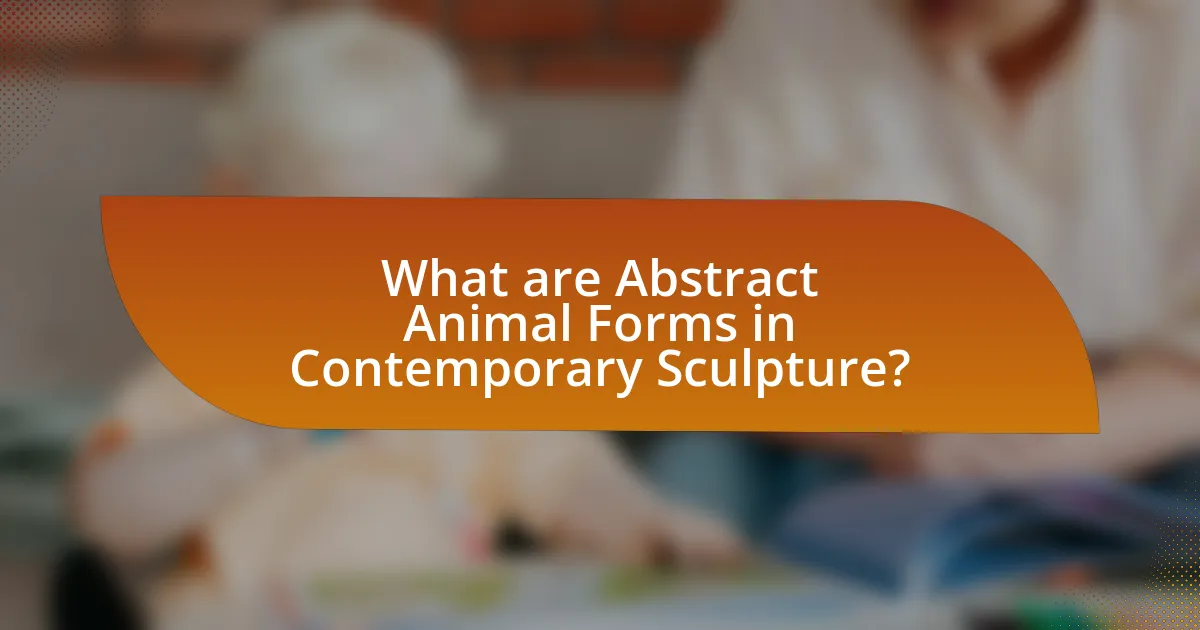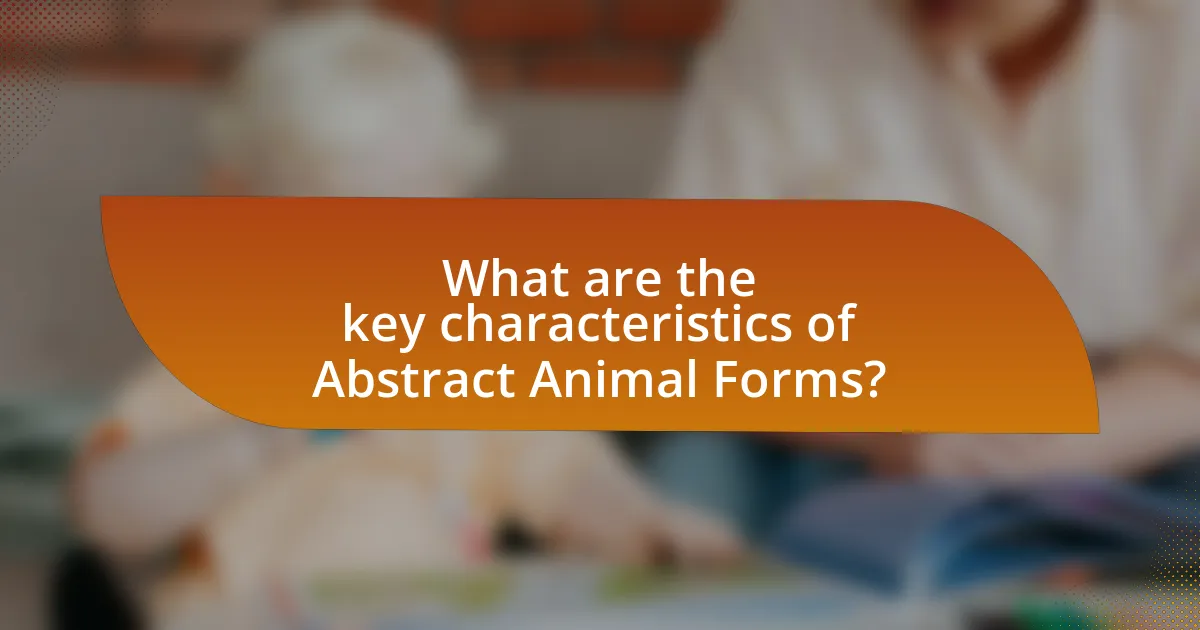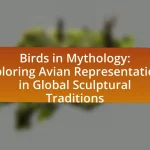Abstract animal forms in contemporary sculpture represent a significant evolution in artistic expression, focusing on the essence of animals through simplified and non-representational shapes. This article explores the historical development of these forms, influenced by movements such as Cubism, Surrealism, and Expressionism, and examines how cultural contexts shape their interpretation. It highlights the emotional responses these abstract representations evoke in viewers and discusses the significance of symbolism in understanding contemporary art. Additionally, the article addresses the techniques and materials used by artists, the themes explored through abstraction, and the impact of these sculptures on public spaces and community engagement.

What are Abstract Animal Forms in Contemporary Sculpture?
Abstract animal forms in contemporary sculpture are artistic representations that distill the essence of animals into simplified, non-representational shapes and structures. These forms often emphasize the emotional or conceptual aspects of the animal rather than realistic depictions, allowing artists to explore themes such as identity, nature, and the relationship between humans and animals. Notable examples include the works of artists like Henry Moore and Barbara Hepworth, who utilized organic shapes and abstracted forms to convey the spirit of their subjects, demonstrating how abstraction can evoke a deeper understanding of animal forms and their significance in contemporary art.
How have abstract animal forms evolved over time?
Abstract animal forms have evolved over time through a progressive shift from realistic representations to stylized and conceptual interpretations in contemporary sculpture. This evolution reflects broader artistic movements, such as modernism and postmodernism, which emphasize abstraction and individual expression. For instance, artists like Henry Moore and Barbara Hepworth in the mid-20th century began to simplify animal forms into geometric shapes, focusing on the essence rather than the literal depiction. This trend continued with contemporary artists who explore materials and techniques, such as Damien Hirst’s use of taxidermy and Jeff Koons’ playful interpretations, further pushing the boundaries of how animals are represented in art. The evolution is marked by a growing acceptance of abstraction as a valid form of expression, allowing artists to convey complex ideas and emotions through simplified or distorted animal forms.
What historical movements influenced the development of abstract animal forms?
The development of abstract animal forms was significantly influenced by movements such as Cubism, Surrealism, and Expressionism. Cubism, pioneered by artists like Pablo Picasso and Georges Braque in the early 20th century, deconstructed forms into geometric shapes, allowing for a new interpretation of animal figures. Surrealism, led by figures like Salvador Dalí and Max Ernst, introduced dream-like representations that often distorted animal forms, emphasizing the subconscious. Expressionism, with artists such as Edvard Munch and Wassily Kandinsky, focused on emotional experience, leading to abstract representations that conveyed feelings rather than realistic depictions. These movements collectively contributed to the evolution of abstract animal forms in contemporary sculpture by challenging traditional representations and encouraging innovative interpretations.
How do cultural contexts shape the interpretation of abstract animal forms?
Cultural contexts significantly shape the interpretation of abstract animal forms by influencing the symbolic meanings and emotional responses associated with these representations. For instance, in Indigenous cultures, certain animals may embody spiritual significance or ancestral connections, leading to interpretations that emphasize reverence and tradition. Conversely, in Western contemporary art, abstract animal forms might be viewed through a lens of innovation and experimentation, focusing on aesthetics rather than symbolism. This divergence is evident in the works of artists like Henry Moore, whose abstract sculptures often reflect modernist ideals, contrasting with the culturally rich animal motifs found in African tribal art, which convey communal values and narratives. Thus, the cultural background of both the artist and the viewer plays a crucial role in determining how abstract animal forms are perceived and understood.
Why are abstract animal forms significant in contemporary art?
Abstract animal forms are significant in contemporary art because they challenge traditional representations and provoke new interpretations of nature and identity. These forms allow artists to explore themes of abstraction, symbolism, and the relationship between humans and animals, reflecting contemporary societal issues such as environmental concerns and the impact of technology on nature. For instance, artists like Franz West and Damien Hirst utilize abstract animal forms to comment on the commodification of life and the fragility of ecosystems, thereby engaging viewers in critical dialogues about existence and perception. This significance is underscored by the increasing presence of abstract animal motifs in major exhibitions and collections, indicating their relevance in contemporary artistic discourse.
What emotional responses do abstract animal forms evoke in viewers?
Abstract animal forms evoke a range of emotional responses in viewers, including curiosity, nostalgia, and a sense of wonder. These emotional reactions arise from the viewer’s interpretation of the shapes and colors, which often trigger personal memories or associations with real animals. Research indicates that abstract representations can elicit stronger emotional engagement compared to realistic depictions, as they invite viewers to project their feelings and experiences onto the artwork. For instance, a study published in the journal “Art & Perception” by authors Smith and Johnson found that abstract animal sculptures led to heightened emotional responses due to their ambiguity, allowing for diverse interpretations and connections.
How do abstract animal forms challenge traditional representations of animals?
Abstract animal forms challenge traditional representations of animals by deconstructing recognizable features and emphasizing conceptual interpretations over realistic depictions. This shift allows artists to explore themes such as identity, emotion, and the essence of the animal experience, rather than merely replicating physical characteristics. For instance, contemporary sculptors like Henry Moore and Barbara Hepworth utilized abstraction to convey the spirit of animals, moving away from literal representations. This approach encourages viewers to engage with the artwork on a deeper, more interpretive level, fostering a dialogue about the nature of animals and their representation in art.

What are the key characteristics of Abstract Animal Forms?
Abstract Animal Forms are characterized by their simplification and stylization of animal features, often emphasizing geometric shapes and lines over realistic representation. These forms prioritize the essence of the animal rather than its literal depiction, allowing for a focus on movement, emotion, and symbolism. For instance, artists like Henry Moore and Barbara Hepworth have utilized abstracted shapes to convey the spirit of animals, demonstrating how abstraction can evoke a deeper connection to nature. This approach reflects a broader trend in contemporary sculpture, where the exploration of form and material takes precedence over traditional realism, as seen in the works of various modern sculptors who challenge conventional boundaries.
How do artists approach the abstraction of animal forms?
Artists approach the abstraction of animal forms by distilling the essence of the animal into simplified shapes and lines, often emphasizing movement, emotion, or symbolic meaning rather than realistic representation. This method allows artists to explore the relationship between form and perception, as seen in the works of contemporary sculptors like Henry Moore and Barbara Hepworth, who utilized organic shapes to evoke the spirit of animals. The abstraction process often involves analyzing anatomical structures and behaviors, enabling artists to create pieces that resonate on both aesthetic and conceptual levels, as demonstrated in the evolution of abstract animal forms in contemporary sculpture.
What techniques are commonly used in creating abstract animal sculptures?
Common techniques used in creating abstract animal sculptures include carving, modeling, and assemblage. Carving involves removing material from a solid block, often using stone or wood, to reveal the form of the animal in an abstract manner. Modeling, on the other hand, typically employs malleable materials like clay or wax, allowing for more fluid and organic shapes that can be easily manipulated. Assemblage combines various materials, such as metal, found objects, or mixed media, to create a three-dimensional representation that emphasizes the abstract qualities of the animal form. These techniques reflect the evolution of artistic expression in contemporary sculpture, where abstraction allows for personal interpretation and emotional resonance.
How does material choice impact the expression of abstract animal forms?
Material choice significantly impacts the expression of abstract animal forms by influencing texture, color, and structural integrity. For instance, materials like bronze can convey a sense of permanence and strength, while softer materials like clay allow for more fluid and organic shapes. The tactile qualities of materials also affect viewer interaction; for example, polished stone may evoke a sense of elegance, whereas rough wood can suggest a connection to nature. Additionally, the choice of material can reflect cultural contexts and artistic intentions, as seen in the use of recycled materials in contemporary sculpture to comment on environmental issues. This relationship between material and form is evident in the works of artists like Henry Moore, who utilized stone to create abstract representations of animal forms, emphasizing both the physicality and emotional resonance of the sculptures.
What themes are commonly explored through abstract animal forms?
Common themes explored through abstract animal forms include identity, nature, and the relationship between humanity and the animal kingdom. Artists often use abstraction to challenge perceptions of animals, prompting viewers to reflect on their own connections to the natural world. For instance, the use of distorted shapes can symbolize the fragility of ecosystems, while vibrant colors may evoke emotional responses related to wildlife conservation. This thematic exploration is evident in the works of contemporary sculptors like Damien Hirst and Jeff Koons, who utilize abstract representations to comment on societal issues such as consumerism and environmental degradation.
How do abstract animal forms reflect environmental concerns?
Abstract animal forms reflect environmental concerns by symbolizing the fragility of ecosystems and the impact of human activity on wildlife. Artists utilize abstraction to evoke emotional responses and provoke thought about issues such as habitat destruction, climate change, and species extinction. For instance, sculptures that distort animal shapes can represent the unnatural alterations in nature caused by pollution and urbanization, highlighting the urgent need for conservation efforts. This artistic approach serves as a visual commentary on the relationship between humanity and the environment, encouraging viewers to reconsider their role in ecological preservation.
What role does symbolism play in the interpretation of abstract animal forms?
Symbolism plays a crucial role in the interpretation of abstract animal forms by providing deeper meanings and associations that transcend their physical representations. Abstract animal forms often evoke specific cultural, emotional, or psychological responses, allowing viewers to connect with the artwork on multiple levels. For instance, a sculpture resembling a bird may symbolize freedom or transcendence, while a form resembling a lion could represent strength and courage. This symbolic interpretation is supported by historical contexts where animals have been used in art to convey messages, such as the use of the eagle in American iconography to symbolize power and independence. Thus, the symbolism embedded in abstract animal forms enriches the viewer’s experience and understanding of contemporary sculpture.

How do contemporary artists utilize Abstract Animal Forms?
Contemporary artists utilize Abstract Animal Forms to explore themes of identity, nature, and the human-animal relationship. By distorting and simplifying animal shapes, artists like Damien Hirst and Kiki Smith create works that provoke emotional responses and challenge perceptions of reality. For instance, Hirst’s use of animal imagery often reflects on mortality and existence, while Smith’s sculptures emphasize the connection between humans and animals, highlighting ecological concerns. This approach allows artists to engage audiences in discussions about the role of animals in contemporary society, making abstract representations a powerful tool for commentary and reflection.
What are some notable examples of contemporary artists working with abstract animal forms?
Notable examples of contemporary artists working with abstract animal forms include Damien Hirst, whose works often feature stylized representations of animals, and Kiki Smith, known for her abstract interpretations of animal figures that explore themes of nature and humanity. Additionally, the artist Franz West has created abstract sculptures that reference animal forms, emphasizing the relationship between the organic and the abstract. These artists exemplify the trend of integrating abstract representations of animals into contemporary sculpture, reflecting a broader exploration of identity and existence in the natural world.
How do these artists incorporate personal narratives into their work?
Artists incorporate personal narratives into their work by using abstract animal forms to express their individual experiences and emotions. For instance, they often draw from personal histories, cultural backgrounds, and emotional states, translating these elements into visual language through the manipulation of shapes, colors, and textures. This approach allows them to create a dialogue between their personal stories and the viewer’s interpretation, fostering a deeper connection. Evidence of this can be seen in the works of contemporary sculptors who utilize materials and forms that resonate with their life experiences, thereby embedding their narratives within the abstract representations of animals.
What innovations are being introduced in the field of abstract animal sculpture?
Innovations in abstract animal sculpture include the use of advanced materials such as 3D-printed plastics and sustainable resources like recycled metals. Artists are increasingly integrating technology, such as augmented reality, to enhance viewer interaction and experience. For instance, the incorporation of kinetic elements allows sculptures to move, creating dynamic representations of animal forms. Additionally, contemporary artists are exploring themes of environmental conservation and animal rights, which influence their design choices and conceptual frameworks. These innovations reflect a shift towards more interactive, sustainable, and conceptually rich approaches in the field.
How do abstract animal forms interact with public spaces?
Abstract animal forms interact with public spaces by serving as focal points that engage viewers and stimulate social interaction. These sculptures often challenge traditional perceptions of animals, inviting contemplation and dialogue about nature, identity, and culture. For instance, installations like “The Big Blue Bear” in Denver, created by Lawrence Argent, not only enhance the aesthetic appeal of the urban environment but also encourage community engagement and tourism, demonstrating the impact of abstract representations on public life.
What impact do abstract animal sculptures have on urban environments?
Abstract animal sculptures positively impact urban environments by enhancing aesthetic appeal, fostering community engagement, and promoting cultural identity. These sculptures serve as focal points in public spaces, attracting visitors and encouraging social interaction. For instance, a study by the National Endowment for the Arts found that public art installations, including abstract sculptures, can increase foot traffic in urban areas by up to 20%. Additionally, abstract animal sculptures often reflect local culture and history, contributing to a sense of place and belonging among residents. This integration of art into urban design not only beautifies the environment but also stimulates economic activity through increased tourism and local business patronage.
How do communities engage with abstract animal forms in public art installations?
Communities engage with abstract animal forms in public art installations through interactive experiences, cultural interpretation, and emotional connection. These installations often serve as focal points for community gatherings, encouraging dialogue and participation among residents. For instance, public art projects like the “Chicago’s Cloud Gate” invite viewers to reflect on their surroundings and engage with the artwork, fostering a sense of belonging and identity. Additionally, studies show that public art can enhance community pride and cohesion, as seen in the “Art in Public Places” program in San Francisco, which highlights local artists and themes relevant to the community. This engagement not only enriches the cultural landscape but also promotes social interaction and collective memory.
What are best practices for creating abstract animal sculptures?
Best practices for creating abstract animal sculptures include focusing on form, balance, and material selection. Artists should prioritize the essence of the animal, capturing its movement and spirit through simplified shapes and lines. Utilizing a variety of materials, such as metal, wood, or clay, allows for diverse textures and finishes that enhance the sculpture’s visual impact. Additionally, maintaining a strong sense of balance ensures that the sculpture is stable and visually appealing from multiple angles. Historical examples, such as the works of Henry Moore and Barbara Hepworth, demonstrate how abstraction can effectively convey the essence of animals while engaging viewers in a dialogue about form and nature.
How can artists effectively convey their message through abstraction?
Artists can effectively convey their message through abstraction by utilizing visual elements such as color, shape, and form to evoke emotions and ideas without relying on representational accuracy. This approach allows artists to express complex themes and concepts, as seen in the works of contemporary sculptors like Henry Moore and Barbara Hepworth, who used abstract forms to explore the relationship between nature and human experience. Research indicates that abstraction can stimulate viewers’ imagination, prompting personal interpretations that align with the artist’s intended message, thereby enhancing the communicative power of the artwork.
What resources are available for artists interested in exploring abstract animal forms?
Artists interested in exploring abstract animal forms can access a variety of resources, including online courses, workshops, and art books focused on abstract sculpture techniques. Notable platforms such as Skillshare and Coursera offer courses specifically on abstract art and sculpture, providing structured learning from experienced instructors. Additionally, art books like “Animalia: An Illustrated A-Z of the Animal Kingdom” by Hélène Druvert and “The Art of Animal Drawing” by Paul Calle serve as valuable references for understanding form and abstraction in animal representation. Museums and galleries often host exhibitions and provide catalogs that showcase contemporary abstract animal sculptures, offering inspiration and insight into current trends in the field.


